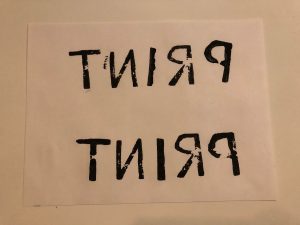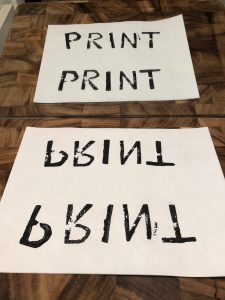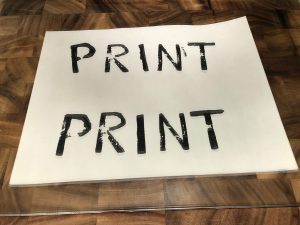
Original print is printed backwards

Using the mirror reflection to have ‘PRINT’ in the correct direction

The reflected ‘PRINT’
Was there something particularly challenging in the process?
From the outset, I thought the entire process was quite challenging. The first step of thinking of a 5-letter word that was did not have repeating words and letters that had primarily straight lines for ease of carving. Some of the finer areas of carving out the letter, for example, inside the ‘P’ and ‘R’ was difficult using the knife point for curved edges. When I completed carving the letters, I realized that I needed to carve them backwards for them to print forwards on the paper. This was a vital error, which I corrected using a mirror to reflect the image of the word. There were also many challenges during the printing process, such as printing the letters straight, spacing between letters, and transferring the ink from the stamps to the paper. I think having some reference points on the paper to match reference points on the potato stamp would have helped print the letter more perpendicular. The second attempt at printing was much more successful in terms of the spacing between the letters. There were consistent areas of the potato stamps that did not stamp with ink, particularly in the middle of the ‘R’ and ‘T.’
How much time did it take for you to create the stamps?
The process of carving the stamps took about 30 minutes. The entire process of carving to stamping took about 60 minutes.
Have you notice anything particular about the letters that you have chosen to reproduce?
The letters that I chose to reproduce are all in upper-case with the greatest number of straight lines. I chose these letters as they are the easiest to carve out of a potato. Letters with more straight lines were easier to cut with one clean cut using a larger knife.
Considering the time and effort that took you to create a 5-letter word, how do you feel about the mechanization of writing?
I feel the mechanization of writing was and is an arduous process, wrought with errors and mistakes. From having to create the stamps to type setting to printing; there are many factors that require precision for a flawless finished product. Carving the stamps presented a challenge of creating a quality product that will translate to the printing process. There were also a series of challenges trying to set the stamps to print straight and with enough ink for a true print, some of the letters were not stamped perpendicular and the spacing between the letters were inconsistent. In addition, ink coverage on the stamps to ensure a quality print was challenging. I consider the process of mechanized writing to be an art form with that artistry in the process of creating from the beginning. Similar to the art form of screen printing, the printing process requires the majority of the work up front which is reflected in the quality of the finished product. I have developed great respect and appreciation for this process and the people who put in the time to create a product that is both informative in content and aesthetically pleasing.
I love your reflection solution! I feel like this wouldn’t be out of place in a contemporary art gallery somewhere, if you added the right caption to it. I definitely share a heightened appreciation for this process now… Thanks for sharing your experiences 😀
I definitely thought the reflection was a bit of a cheat.
And if this potato print can pass as contemporary art, I think I might have found a new side hustle.
So! This stuck in my brain so much I ended up using it for my linking assignment 🙂 Thanks for the inspiration https://blogs.ubc.ca/jamiedimitra/linking-assignment/text-as-reflection/
I came to check out your print, after your comment during our video chat. I too chose to use ALL CAPITALS they have less curves and seemed easier to print!
How did you apply your ink to your potato? What ink did you use? and What type of potato?
My potato was very juicy, which may have affected my print. I found the letter I the easiest to print and I have to confess I did not space out my letters as nicely as yours. I see you used multiple potatoes this would have allowed you to adjust the gaps between the letters. I just used one. I had to cut it in such a way as to get the most surface area so my letters would fit. You can re-arrange yours and make more words….if you have the right letters.
Thanks for sharing with us!
Hi Sarka,
I basically followed the ‘how to’ video posted below the task description. I used an acrylic paint (which my daughter uses for art at home) and painted the paint on the potato stamp with a paint brush. I feel I get consistent coverage on the stamp that way. I bought a few basic Russet potatoes, they had some juice one the surface, so I had to pat them down with a paper towel prior to applying the paint. I tried it without patting it down but it was difficult to apply the paint evenly. I used 2 potatoes, but I bought large ones, purposely with this task in mind. Russets are large enough to cut into pieces that can still have surface area and thickness to carve the stamp. I agree, using the stamps to make other words is actually a great primary literacy activity, I’ve done that before, but not with potatoes though. Thanks for your post!
I love your potato print, like yourself I didn’t realize you had to reverse them when cutting them out. I didn’t realize you could use a mirror to change them. For me I went back to the drawing board and had to come up with new words, get new potatoes, and a new headache lol. Thanks for sharing!
Thanks for the comment. I was kicking myself for not remembering the reflection problem for printing. I had taken a screen printing class at Emily Carr many years ago and that is the first technical thing they tell you right at the beginning, that everything comes out in reverse. I bet it’s no problem to get new potatoes, I roasted them for dinner after I was done the task!